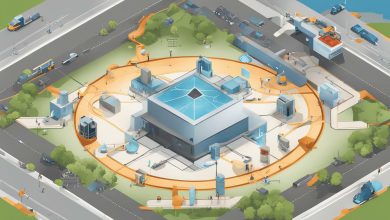
As businesses seek to leverage the power of the Internet of Things (IoT) for transformative outcomes, edge computing has emerged as a key enabler. At the heart of this trend is Azure IoT Edge, a powerful platform that allows organizations to harness the full potential of edge computing for advanced analytics, real-time insights, and optimized operations.
With Azure IoT Edge, businesses can run advanced analytics and machine learning models on edge devices, reducing the need for transmitting large amounts of data to the cloud. This approach enhances efficiency and reduces latency, enabling businesses to make informed decisions faster. In addition, Azure IoT Edge provides advanced security features, ensuring that data is protected at all times.
To succeed in the fast-evolving IoT landscape, businesses must embrace edge computing and explore the capabilities of Azure IoT Edge. The benefits are clear:
Key Takeaways:
- Azure IoT Edge enables businesses to leverage the power of edge computing for advanced analytics and machine learning
- Edge computing reduces latency and increases efficiency, enabling faster decision-making
- Azure IoT Edge provides advanced security features, ensuring data protection at all times
Understanding Azure IoT Edge and Its Components
As businesses look to leverage the benefits of edge computing, Azure IoT Edge has emerged as a leading platform for deploying and managing edge solutions. At its core, Azure IoT Edge is designed to enable real-time processing and reduce latency by performing data analysis and actions locally on devices. This not only improves response times but also enhances data security by reducing the need to transmit data to the cloud.
Azure IoT Edge consists of various interrelated components that work together to deliver these advantages. At its core, Azure IoT Edge includes IoT edge devices, which refer to any device that can run Azure IoT Edge runtime. These can range from sensors and gateways to servers and PCs. In addition, Azure IoT Edge also includes edge gateways, which serve as intermediaries between edge devices and the cloud. They can perform tasks such as protocol translation, data filtering, and local analytics.
By using Azure IoT Edge, businesses can take advantage of the rich analytics capabilities of the Azure IoT platform. This provides a scalable and secure way to connect and manage devices at scale. The ability to run analytics models directly on edge devices also enables real-time insights and faster decision-making, while reducing bandwidth costs and dependency on cloud connectivity.
Leveraging Azure IoT Edge for Advanced Analytics
Azure IoT Edge integrates with the Azure IoT platform, offering businesses an opportunity to connect, monitor, and manage devices at scale. This enables the collection of massive amounts of data, which can then be analyzed in real-time for faster insights and decision-making.
One of the key advantages of Azure IoT Edge is the ability to run complex analytics models directly on edge devices. This means that valuable insights can be generated instantly, without the need to transfer data to the cloud for processing. This reduces latency, enhances data security, and optimizes processes.
Edge computing with Azure IoT Edge offers businesses the opportunity to leverage advanced analytics for transformative business outcomes. By analyzing large volumes of data in real-time, organizations can gain a competitive advantage.
The Benefits of Azure Edge Services
Azure IoT Edge offers advanced edge computing capabilities that enable businesses to process data at the edge, reducing response times and bandwidth costs. Azure Edge Services further enhance these benefits, providing flexible and scalable solutions that adapt to changing requirements and handle diverse workloads.
By utilizing Azure Edge Services with Azure IoT Edge, businesses can improve their operational efficiency while gaining a competitive advantage. The benefits of Azure Edge Services include:
| Benefit | Description |
|---|---|
| Latency Reduction | Edge computing with Azure Edge Services enables data processing at the edge, minimizing response times. |
| Bandwidth Optimization | Azure Edge Services reduces data transfer costs by enabling efficient data processing at the edge. |
| Scalability | Azure Edge Services provides a flexible and scalable platform that adapts to changing business needs. |
With Azure Edge Services, businesses can leverage the full potential of Azure IoT Edge and edge computing. By reducing latency and optimizing bandwidth, they can unlock real-time processing capabilities and make faster, more informed decisions. Furthermore, the scalability of Azure Edge Services ensures that businesses can handle complex workloads and adapt to evolving requirements.
Overall, Azure IoT Edge and Azure Edge Services provide powerful solutions for organizations looking to leverage the benefits of edge computing. From optimized data processing to improved operational efficiency, these technologies enable transformative business outcomes that can give companies a competitive edge in the evolving IoT landscape.
Conclusion
As we’ve explored throughout this article, Azure IoT Edge holds immense potential for businesses looking to leverage edge computing for advanced analytics and faster decision-making. With its key components such as IoT edge devices and edge gateways, Azure IoT Edge enables real-time processing, reduces latency, and enhances data security.
By utilizing Azure Edge Services with Azure IoT Edge, businesses can also improve operational efficiency, handle diverse workloads, and reduce bandwidth costs. It’s clear that exploring Azure IoT Edge is an essential step for any organization seeking to stay competitive in the evolving IoT landscape.
So, what are you waiting for? Begin your Azure IoT Edge journey today, and unlock the full potential of edge computing to achieve transformative business outcomes.
FAQ
Q: What is Azure IoT Edge?
A: Azure IoT Edge is a platform for deploying and managing edge computing solutions.
Q: How can Azure IoT Edge help businesses?
A: Azure IoT Edge enables organizations to leverage advanced analytics and machine learning for efficient results.
Q: What are the key components of Azure IoT Edge?
A: The key components of Azure IoT Edge include IoT edge devices and edge gateways.
Q: What are the benefits of edge computing with Azure IoT Edge?
A: Edge computing with Azure IoT Edge enables real-time processing, reduces latency, and enhances data security.
Q: How does Azure IoT Edge integrate with the Azure IoT platform?
A: Azure IoT Edge integrates with the Azure IoT platform, allowing businesses to connect, monitor, and manage devices at scale.
Q: What capabilities does Azure IoT Edge offer for advanced analytics?
A: Azure IoT Edge allows businesses to run complex analytics models directly on edge devices, enabling real-time insights and faster decision-making.
Q: What are the benefits of utilizing Azure Edge Services with Azure IoT Edge?
A: Utilizing Azure Edge Services with Azure IoT Edge enables efficient data processing at the edge, reduces bandwidth costs, and improves response times.
Q: How flexible and scalable are Azure Edge Services?
A: Azure Edge Services offer flexibility and scalability, allowing businesses to adapt to changing requirements and handle diverse workloads.
Q: Can you provide examples of Azure Edge Services delivering value?
A: Azure Edge Services have showcased tangible value and competitive advantage in various use cases, optimizing processes and improving operational efficiency.
Q: What is the importance of embracing Azure IoT Edge?
A: Embracing Azure IoT Edge is essential to unlock the full potential of edge computing and stay competitive in the evolving IoT landscape.








